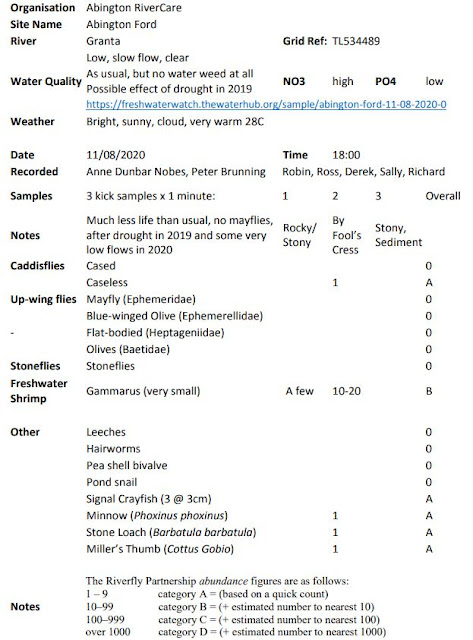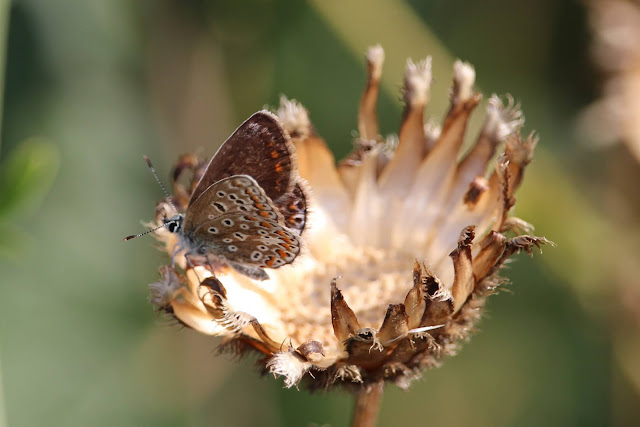Sightings and news for the Naturewatch group of Great and Little Abington in Cambridgeshire, UK. See below for more details and information on how to join.
Saturday, 15 August 2020
Chiffchaff and Goldcrest
Thursday, 13 August 2020
Common Darter
In discussion with Darren B, the characteristic features of this species are the red T-shaped pattern on the abdomen, and the pale yellow stripe just discernible on the legs.
Himalayan Balsam
News: Spotted Flycatcher in the village
Derek T was lucky enough to have a Spotted Flycatcher visit his Cambridge Road garden today and, as is typical for this species, watched it darting out and back from the same perch to catch flies.
Whilst it is possible this is a local bird, there have been no other reports of Spotted Flycatcher in the village this year, so it may well be that this bird has bred elsewhere and is now travelling through on it's way back to southern Africa where they spend the winter.
Some may remember Michael Holdsworth's excellent talk at a recent ANW meeting. His research project into the migration of this species has now completed and further information may be found at: http://cambridgeshirebirdringing.org/2704-2/
River sampling results - 11th August
The results are indicated below, as well as a few photos:
Members and supporters may be interested in the very worthy Chalk Aquifer Alliance to which the CVF is affiliated as a group. If you would like to be alerted to their activities you can subscribe to their mailings at
Monday, 10 August 2020
News: Rare bird spotted along the river
David P was lucky enough to spot a rather rare bird in the river on Saturday morning - a 'first' for The Abingtons!
A large but elusive bird, roughly the size and shape of a heron, with characteristic black, brown and buff streaked plumage, a long 'dagger' bill, and long neck and legs, this Bittern was spotted lurking in the undergrowth along the edge of the river by the cricket ground. Being a shy bird, it didn't stay long, and after a short period, flew off over the High Street along the river towards Linton.
Until recently, the Bittern was extremely rare in the UK, with a few as eleven birds nationally in the 1970's. However, thanks to a sustained effort by conservation organisations, the number of breeding sites in the Cambridgeshire fens has now increased to around 20-30. Unobtrusive, and only rarely seen, Bitterns breed only in large reedbeds and are seldom seen away from this environment in the breeding season. However, later in the year both adults and young may disperse somewhat, and there generally are a number of records of sightings in South Cambs during the 'winter season', although again these are largely associated with reedbeds or gravel pits.
Never previously reported in the Abingtons, one can only assume that this was one such 'travelling' bird, that saw the Abington river as a convenient stop-off point.
Sunday, 9 August 2020
Roman Road survey
Of particular note was the sighting of a Chalkhill Blue butterfly. Jennifer H commented that this record was the first in the Abington parishes for twenty years. Up until now, the nearest records were also from the Roman Road, but on the west side of the A11 where the specific food plants (Horseshoe Vetch) were planted to encourage them.
Worsted Lodge Roman Road survey. 8th August 2020. Project Team (limited)
Butterfly species
|
||
Meadow Brown
|
Small White
|
Red Admiral
|
Gatekeeper
|
Green-veined White
|
Chalkhill Blue
|
Small Heath
|
Large White
|
Common Blue
|
Essex Skipper
|
Brimstone
|
|
Flora species
|
||
Common Knapweed
|
Common Restharrow
|
Spear Thistle
|
Goat’s Beard
|
Lady’s Bedstraw
|
Bladder Campion
|
Yarrow
|
Ragwort
|
Wild Basil
|
Common Toadflax
|
Field Scabious
|
Mugwort
|
Common Mallow
|
Small Scabious
|
Golden Rod
|
Dark Mullein
|
Common St John’s Wort
|
Common Storksbill
|
Dwarf Thistle
|
||
Bird species
|
||
Yellowhammer
|
Linnet
|
Goldfinch
|
Magpie
|
||
Other species
|
||
Red-tailed Bumblebee
|
Honey Bee
|
Wasp nest (in burrow)
|
Buff-tailed Bumblebee
|
Wool Carder Bee
|
Rose Bedeguar Gall
|
White-tailed Bumblebee
|
Cinnamon Bug
|
Cinnabar Moth caterpillar
|
along veins. Female lacks the black sex-brand (stripe) of the male.
The Aims of Abington Naturewatch
At their meeting on 9 April 2005 the members approved this revised version of the aims of Abington Naturewatch:
- To monitor and record the wildlife (fauna & flora) within the borders of the Abingtons;
- To encourage protection of our wildlife, maintain its quality and foster its diversity;
- To promote awareness of the richness, potential and problems of the natural environment of the Abingtons;
- To cooperate in improving access to the local natural environment for the benefit of all Abington villagers.
The organisation is informal and communication is by email if possible; members are notified of events from time to time. Contact details are maintained by a small "project team". There is currently no membership fee as costs are covered by voluntary contributions at events.
Members are encouraged to report notable sightings of flora and fauna within the Abingtons to the appropriate sector coordinator and an illustrated record is published annually.
A map of the area covered, with some features noted, is available here: http://maps.google.co.uk/maps/ms?ie=UTF8&hl=en&msa=0&msid=213774935674882866424.00000111dca2be9f06ab8&z=13>
For more information or to join, please contact David Farrant on (01223) 892871.
Contributions to our records should be sent to sector contacts or either of the above. Photographs may also be submitted to Andy Merryweather (amerryweather61@gmail.com)
























































